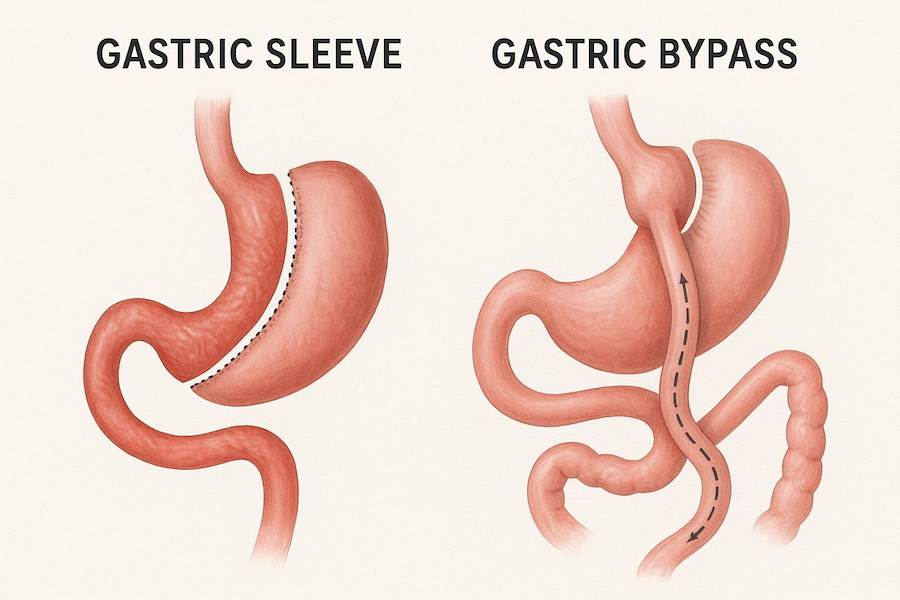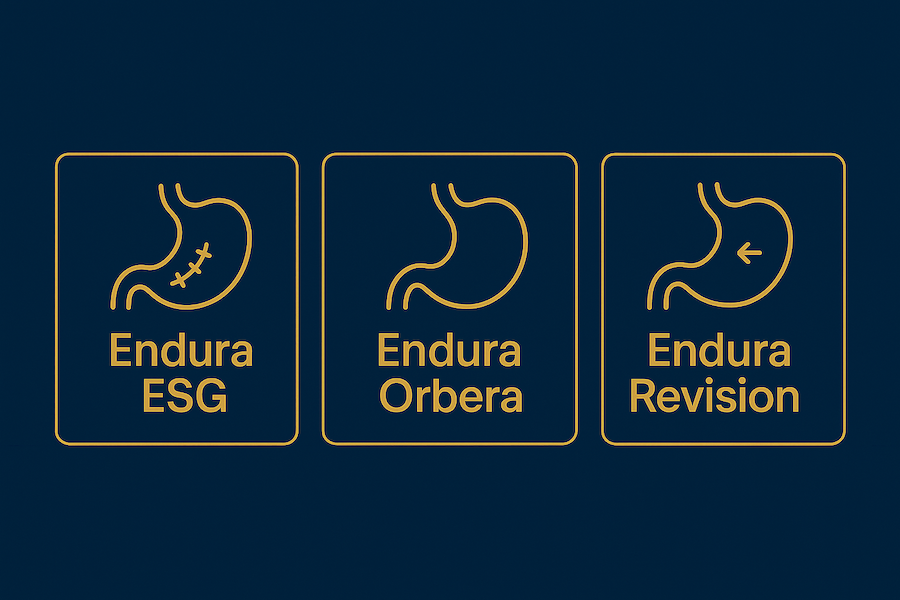Gastric Sleeve vs Bypass: The Differences + Safer Alternatives
Comparing gastric sleeve vs gastric bypass? Explore the differences, how each surgery works, and discover a safer alternative that could be right for you.

Bariendo Team
Team @ Bariendo
Considering weight loss surgery is a big step. It often comes after years of frustration with diets that didn’t stick, workouts that didn’t deliver, and the frustrations of regaining any weight you did manage to lose.
Now, you’re here, comparing gastric sleeve and gastric bypass, trying to figure out which one is safer, more effective, and the best fit for you. But with all the medical jargon and mixed opinions out there, the choice can feel more confusing than empowering.
Below, we’ll compare gastric sleeve vs gastric bypass surgery side-by-side. We’ll break down the differences, how each surgery works, what to expect, and who they’re best for. We’ll also introduce a non-invasive alternative that offers real results without surgery, scarring, or a long recovery time.
What is the Difference Between Gastric Sleeve vs Gastric Bypass?
Gastric sleeve and gastric bypass are two of the most common weight loss surgeries, but they work in very different ways. Gastric sleeve reduces the size of the stomach only, while gastric bypass changes both stomach size and how your body digests food.
Gastric sleeve surgery, also called sleeve gastrectomy, removes about 80% of the stomach. What’s left is shaped into a narrow, sleeve-like pouch that holds less food. This helps reduce hunger and limits how much you can eat at once.
Gastric bypass surgery, or Roux-en-Y Gastric Bypass, is more complex. During this surgery, the stomach is divided into two, a larger pouch and a smaller pouch. The digestive tract is rerouted to the smaller pouch so that food skips part of the small intestine. This limits both how much you can eat and the amount of calories and nutrients your body absorbs.
Both surgeries can lead to extreme weight loss, but they can differ in terms of risks, results, recovery, and long term impact.
Comparing Gastric Sleeve vs Gastric Bypass
Now that you understand the main difference between gastric gastric sleeve vs bypass, let’s take a closer look at how they compare side by side. From recovery time to potential risks and long-term results, here’s how these two surgeries stack up across the factors that matter most.
Recovery and Downtime
Gastric sleeve and gastric bypass are both major surgeries that take time to heal, but recovery from gastric sleeve is typically shorter. Most patients who undergo gastric sleeve surgery stay in the hospital for one to two days.
Recovery at home can take two to four weeks. Gastric bypass surgery typically requires a two to three day hospital stay and significantly longer recovery period of about six weeks. Because this surgery is more complex, patients also experience more discomfort, fatigue, and dietary restrictions during recovery.
In short, gastric sleeve surgery typically comes with less downtime and an easier recovery over all.
Potential Risks and Complications
Gastric sleeve surgery is less complex than gastric bypass, and typically comes with a lower risk profile.
According to studies, the overall incidence of postoperative complications after laparoscopic sleeve gastrectomy is approximately 2.12%. More serious complications, such as leakage from the stapled area, bleeding, or infection is even lower, occur in less than 1% of patients. However, new or worsening acid reflux (GERD) is quite common, and may increase the risk of esophageal cancer over time.
Gastric bypass surgery comes with a higher complication rate of about 3.02% for laparoscopic Roux-en-Y gastric bypass patients. Potential risks include nutritional deficiencies due to altered digestion and absorption, as well as dumping syndrome, which can cause nausea, dizziness, and diarrhea when food moves through the digestive system too quickly.
Unfortunately, about ⅓ to ½ of gastric bypass patients also develop gallstones after the surgery. While both procedures have very low mortality rates and are generally considered safe, it’s important to be aware of the potential risks and discuss them with your doctor.
Weight Loss Results
Both gastric sleeve and gastric bypass typically lead to significant weight loss, but the speed of weight loss and overall results differs between the two.
On average, gastric sleeve patients lose about 25% of their total body weight within the first 12 to 18 months after surgery. Results tend to be gradual and consistent when combined with healthy lifestyle changes and long term support.
Gastric bypass patients typically lose around 30-35% of their total body weight in a similar time frame. Because the surgery also reduces calorie absorption, weight loss tends to happen a bit faster in the early months.
Unfortunately, weight regain is quite common with both surgeries, especially if proper dietary and exercise guidelines aren’t followed. The key to long-term success is ongoing healthy habits and support from a dedicated care team.
Potential Health Benefits
In addition to weight loss, both gastric sleeve and gastric bypass can lead to significant improvements in obesity related health conditions. Many patients see a reduction or complete resolution of conditions like type 2 diabetes, high blood pressure, sleep apnea, and high cholesterol within a few months of either surgery, with continued improvements as more weight is lost.
Gastric bypass tends to have a stronger and faster impact on type 2 diabetes, with some patients experiencing remission even before weight loss occurs, likely due the the way the surgery alters the digestive system and hormone responses.
However, gastric sleeve also has positive effects on blood sugar and other metabolic conditions, especially when combined with healthy lifestyle changes. While results can vary, booth procedures have been shown to reduce the risk of chronic disease, and in many cases, increase longevity and improve quality of life.
Lifestyle Changes After Surgery
No matter which weight loss method you choose, long-term success depends heavily on post-surgery diet and lifestyle habits. Both gastric sleeve and gastric bypass patients must commit to a structured diet that begins with liquids and gradually progresses to soft foods and then solid foods. Portion sizes are much smaller than before, and eating too quickly or too much can lead to discomfort or complications.
Daily vitamin and mineral supplements are usually required, especially after gastric bypass, to prevent deficiencies due to reduced food intake and nutrient absorption. Regular exercise is also essential, not just for weight loss, but also to maintain muscle mass, improve energy levels, and support overall health.
Reversibility and Revision Options
Gastric sleeve surgery is not reversible. During this procedure, about 80% of the stomach is permanently removed. Once that part of the stomach is gone, it cannot be restored.
Gastric bypass surgery is technically reversible, but it’s rarely done because it is so complex. During the surgery, the stomach is divided into and the digestive system is rerouted to the smaller pouch. While the anatomy can be surgically reconnected, it carries additional risks and doesn’t fully restore the body to its pre-surgery state.
Surgical revision is available for both surgeries, but comes with potential risks and extended recovery times. However, for patients who have undergone either surgery and are experiencing weight regain, endoscopic revision procedures offer a safer, less-invasive alternative compared to traditional revision surgery.
For gastric sleeve patients experiencing weight regain, the Sleeve-in-Sleeve (SIS) procedure can re-tighten the stomach pouch, helping patients get back on track with their weight loss goals. For gastric bypass patients, the Transoral Outlet Reduction (TORe) procedure can reduce the size of the gastrojejunal anastomosis (the connection between the stomach pouch and small intestine), addressing weight regain effectively.
Suitability for Different Candidates
While both gastric sleeve and gastric bypass are effective weight loss procedures, they may be better suited for different types of patients depending on individual health conditions and goals.
Gastric sleeve is often recommended for patients with a BMI between 35-40 and fewer obesity related health conditions. Gastric bypass is typically recommended for those with a BMI over 40 or those with complex metabolic conditions like type 2 diabetes or severe acid reflux (GERD).
Which is Better, Gastric Bypass or Gastric Sleeve?
There’s no one-size-fits-all answer. Both gastric sleeve and gastric bypass can lead to significant weight loss, and the better choice depends on your individual health and your weight loss goals.
Gastric bypass may be ideal for patients with severe obesity, type 2 diabetes, or chronic acid reflux. It typically leads to more rapid weight loss and stronger metabolic improvements but comes with a higher risk of complications and nutritional deficiencies.
Gastric sleeve is often preferred by patients who want a less complex procedure. It has a shorter recovery time and carries few risks than gastric bypass.
However, it’s important to know that surgery isn’t the only option when it comes to highly effective weight loss procedures. If you’re looking for a non-invasive weight loss option with a short recovery period and fewer risks, there’s another path worth exploring: Endoscopic Sleeve Gastroplasty (ESG).
Exploring a Safer, Non-Invasive Alternative
If the ideas of invasive surgery, long recovery time, and potential complications give you pause, you’re not alone. Many people are now looking for options that offer real results without surgery, and that’s where Endoscopic Sleeve Gastroplasty (ESG) comes in.
What is Endoscopic Sleeve Gastroplasty (ESG)?
ESG Stomach Tightening, or Endoscopic Sleeve Gastroplasty, is a non-surgical, non-invasive weight loss procedure that reduces the size of the stomach without any external incisions or permanent alterations. It was invented by Dr. Christopher C. Thompson, a world-renowned leader in endobariatrics and co-founder of Bariendo.
During the ESG procedure, a flexible tube with a camera and suturing device attached, is passed through your mouth and into the stomach. The doctor places a series of stitches to re-shape the stomach into a smaller, sleeve-like shape, reducing its size by 60-75%. This helps you feel full sooner, eat less, and lose weight over time.
How ESG Compares to Sleeve Gastrectomy and Gastric Bypass
ESG offers comparable weight loss benefits, but with fewer risks, minimal downtime, and no external incisions or scars. Unlike gastric sleeve and bypass surgeries, ESG is performed entirely through the mouth using a flexible endoscope.
A major pro of ESG is that it’s performed on an outpatient patient basis. Patients go home the same day and return to normal activities, including exercise, in 1-3 days. The risk of complications is also lower with ESG, and there’s a much lower chance of gastrointestinal issues like reflux or nutritional deficiencies.
Patients who undergo ESG typically lose about 18% of their body weight in the first year. They also experience significant improvements or reversal of obesity related health conditions like type-2 diabetes, sleep apnea, fatty liver disease, and more.
The procedure is designed to be permanent, but it can be completely reversed if unexpected complications arise. For many people, ESG strikes the perfect balance between effective weight loss and minimal risk, making it an increasingly popular alternative to bariatric surgery.
ESG Stomach Tightening at Bariendo
At Bariendo, we understand that choosing a weight loss solution is a significant decision and selecting the right provider is crucial to your success. Co-founded by Dr. Christopher C. Thompson, the inventor of ESG himself, Bariendo brings unmatched expertise to every step of the patient experience.
Our ESG Stomach Tightening procedure is offered at a clear, all-inclusive price of $12,995. This includes everything from pre-procedure bloodwork and IV hydration therapy to registered dietitian consultations and 12 months of follow-up care with our dedicated team. There are no hidden fees or surprise charges—just straightforward pricing and flexible financing options that make care more accessible.
But our biggest differentiator is the care you receive before, during, and after your procedure. Bariendo patients are supported by a team of medical professionals who specialize in helping people build long-term success. From personalized nutrition and behavior coaching to responsive communication and ongoing check-ins, we make sure you never have to navigate this journey alone.
Making an Informed Choice
Gastric sleeve and gastric bypass are both effective tools for significant weight loss, but they’re not the only options available. If you’re unsure about surgery or prefer a non-invasive approach, reach out to our team to learn more about ESG Stomach Tightening.
We’re here to help you explore your options with confidence. Schedule a free consultation today to learn if ESG is the right fit for your weight loss goals.

